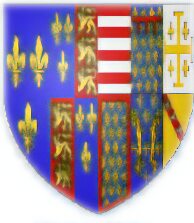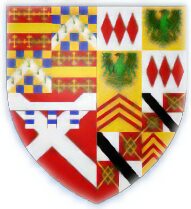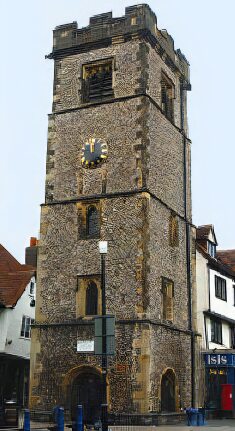17th February 1461
By the Act of Accord, passed on 25 October 1460, King Henry VI was allowed to retain England's throne for the remainder of his life, but following his death Richard Duke of York and his heirs were to inherit the kingdom.
Arms of Margaret of Anjou
The agreement disinherited Henry's young son Edward of Lancaster. Henry's strong-willed queen, Margaret of Anjou, refused to accept this unpalatable situation and took her son to Scotland to gather an army to fight for the rights of her son.
Nobles loyal to the House of Lancaster meanwhile mustered an army in the north of England and attacked York at his castle of Sandall, who was intending to spend the Christmas season there. At the Battle of Wakefield, the Yorkist army was annihilated and York, and his ally the Earl Salisbury and York's seventeen year old second son, Edmund, Earl of Rutland, were all slain by the victorious Lancastrians. After the battle Margaret of Anjou had the heads of York, Rutland and Salisbury impaled on spikes and displayed over Micklegate Bar, the western gate through the York city walls, York's was crowned with a paper crown in derision.
Arms of Warwick the Kingmaker
Margaret was advised to march hastily from York to London to set the king at liberty. York's eldest son, Edward Earl of March and Salisbury's son, Richard, Earl of Warwick, eager to avenge their father's deaths, attempted to prevent the Lancastrian army reaching the capitol. While Edward was occupied in the Marches, Warwick, accompanied by his brother, John Neville, Lord Montagu and the Duke of Norfolk, marched north from London, taking King Henry VI with him and clashed with the Lancastrian forces at St. Albans.
Lacking reliable intelligence, the outnumbered Warwick established his army in four separate defensive positions stretching from St Albans to Nomansland Common, some four miles away. Pavises studded with spikes and calthrops, multi spiked pieces of metal designed to repel cavalry, were set up in anticipation of the arrival of the Lancastrian army. A Kentish squire named Henry Lovelace, employed in Warwick's ranks, revealed details of his position to the Lancastrians and Queen Margaret launched a surprise attack on the flank of the Yorkist army.
St. Albans Main Street
The Lancastrians, led by the Duke of Somerset, the Earl of Northumberland and Lord Clifford, whose fathers had been killed by York and Warwick at the First Battle of St Albans, marched through the night arriving at St Alban's at dawn on the cold winters day of 17th February.
Sir Andrew Trollope led an advance up Fishpool Street towards St. Albans Abbey. He attempted to surprise the archers remaining in the town who were positioned around the clock tower but was repulsed. Due to poor communications, none of the other Yorkist divisions dispatched aid to the archers, who fought on in the February snow. The archers put up a valiant resistance but by noon they were overcome which freed the Lancastrians to deal with Warwick's isolated Yorkist positions one at a time.
Around noon, Trollope's division and the main body of the Lancastrian army, led by Henry Beaufort, Duke of Somerset, attacked Montague's division who were positioned on Bernards Heath. The snow blew into the Yorkists faces and hindered their response. The snow and wind probably also hampered the use of gunpowder or archers. In the furious hand-to-hand fighting which ensued, the Yorkists fought determinedly, and repeatedly repulsed the Lancastrian attacks, but in the confusion of the fighting lost control of the King.
Messengers requesting aid were sent to Warwick, who was initially confused as to what was happening due to the poor visibility and fearing treachery was reluctant to abandon his carefully prepared position, finally, they succeeded in convincing him of the true position, and he ordered an advance south to aid his brother, but it was too late. Montague's division had been broken and was in flight. Warwick's division briefly clashed with the Lancastrians, at which the traitor Henry Lovelace and his force immediately deserted the Yorkists.
In the face of his crumbling lines and obvious defeat, Warwick withdrew in disciplined order leaving behind the bewildered King Henry, John Neville, Lord Montague was captured, Sir John Grey, the first husband of Elizabeth Woodville, later to become Queen, was killed in the fighting, Sir Andrew Trollope had been injured when he stood on one of Warwick's caltrops
Henry was reunited with Margaret of Anjou in Lord Clifford's tent and went to give thanks at St Alban's shrine in the Abbey. The king was reputed to have spent the battle beneath an oak tree, while the battle raged. Two Yorkist knights, Lord Bonville and Sir Thomas Kyriell, a veteran leader of the Hundred Years War, had sworn to protect the king and remained with him.
The following morning, at an impromptu court, Queen Margaret asked her son, the seven-year-old Edward of Lancaster, Prince of Wales, how the two knights should die. The child ordered them to be beheaded. Henry pardoned Montague, whom he was fond of and had served as his chamberlain.
Warwick marched west to join forces with the approaching Yorkist army under Edward, leaving London undefended. The citizens of London refused to open the gates to the Lancastrians forcing them to withdraw north to Yorkshire. Edward, Earl of March, York's able eldest son, aged eighteen and now leader of the Yorkist cause, retaliated and defeated the Lancastrians at Mortimers Cross. He continued to utterly crush the Lancastrian cause at the decisive and bloody Battle of Towton in Yorkshire. The new Duke of York was crowned at Westminster as King Edward IV
The Battle of Northampton PreviousNext The Battle of Mortimers Cross
